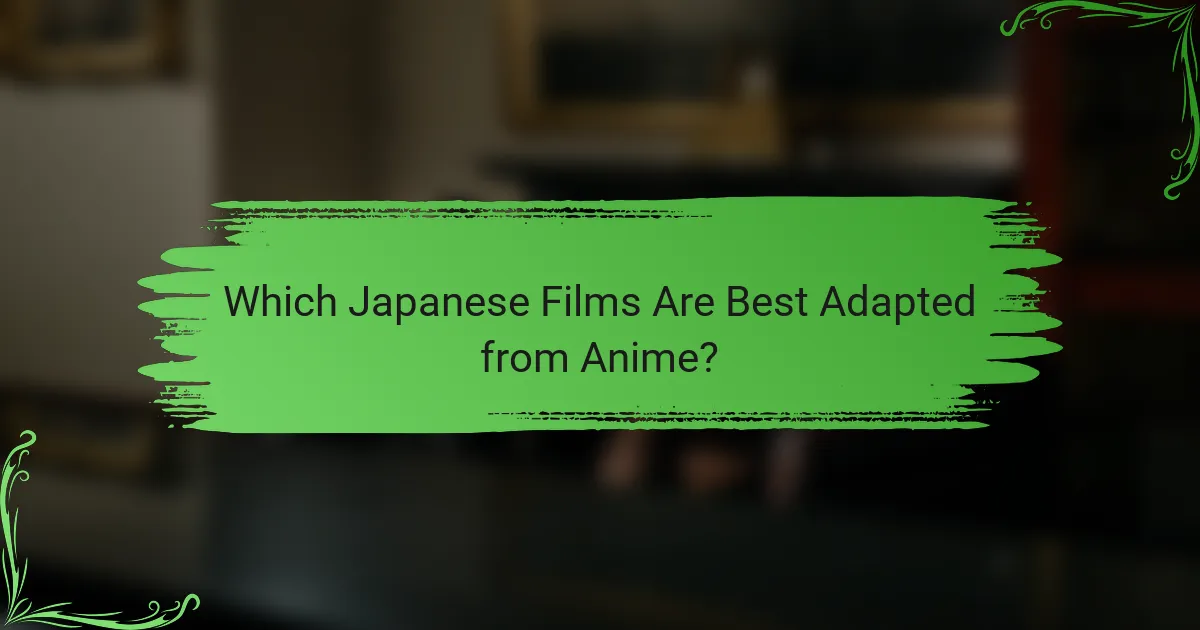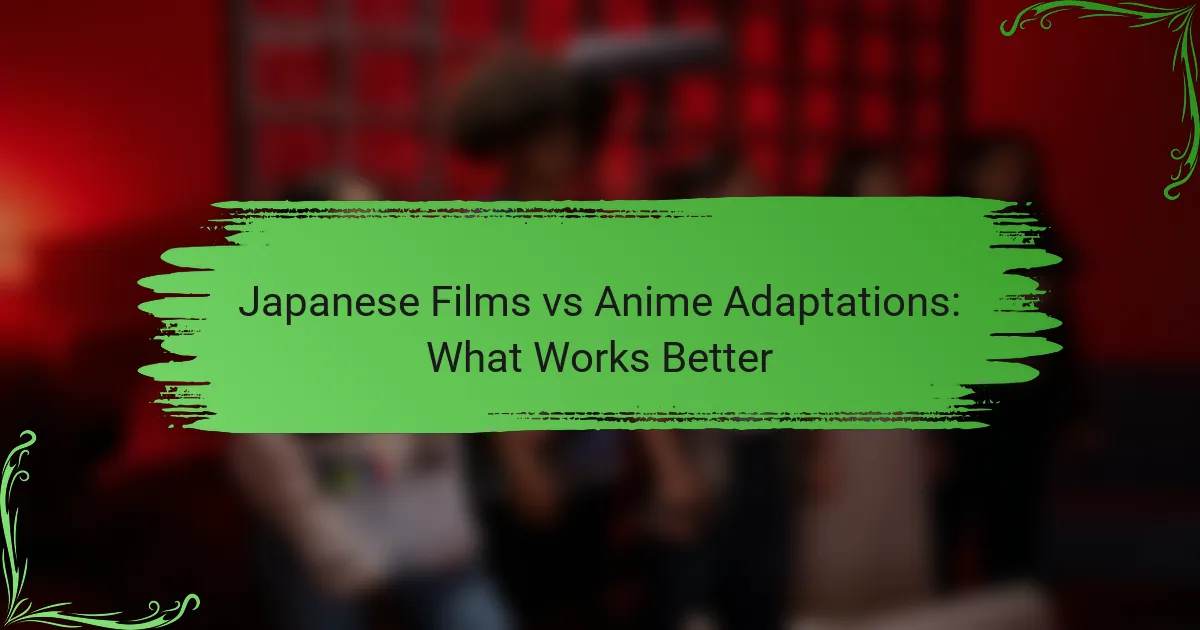The debate between Japanese films and their anime adaptations centers on how effectively each medium conveys the original story’s essence. While films often aim for broader appeal with polished visuals and emotional depth, anime adaptations tend to resonate more with dedicated fans through their unique storytelling techniques and character portrayals. Understanding these differences can enhance appreciation for both forms of storytelling.

Which Japanese Films Are Best Adapted from Anime?
Several Japanese films have successfully adapted anime, capturing the essence of the original stories while appealing to a broader audience. Key adaptations often retain the visual style and emotional depth of their source material, making them popular among both anime fans and newcomers.
Spirited Away
Spirited Away, directed by Hayao Miyazaki, is a landmark film that showcases the beauty of traditional animation while telling a compelling story. Although it is not a direct adaptation of an anime series, it has inspired numerous anime works and remains a quintessential example of how anime aesthetics can translate into film.
The film follows a young girl, Chihiro, who becomes trapped in a spirit world. Its rich visuals and deep themes resonate with audiences, making it a prime example of how animated storytelling can achieve cinematic success.
Attack on Titan
The Attack on Titan live-action films attempt to bring the popular anime series to life, but they have received mixed reviews. While the original anime is known for its intense action and complex narrative, the films struggled to capture the same depth and pacing, often condensing the story significantly.
Fans should be aware that while the films offer a different perspective, they may not fully satisfy those familiar with the anime’s intricate plot and character development. It’s essential to approach these adaptations with tempered expectations regarding their fidelity to the source material.
Your Name
Your Name, directed by Makoto Shinkai, is another successful adaptation that has garnered international acclaim. The film beautifully blends romance and fantasy, telling the story of two teenagers who mysteriously swap bodies. Its stunning animation and emotional storytelling have made it a favorite among both anime enthusiasts and general audiences.
The film’s success demonstrates that a well-crafted anime can transition effectively to film, maintaining its charm and narrative strength. Viewers appreciate the film’s ability to evoke deep emotions while showcasing breathtaking visuals, making it a standout example of anime adaptation.

What Are the Key Differences Between Japanese Films and Anime Adaptations?
Japanese films and anime adaptations differ significantly in their visual presentation, storytelling techniques, and character portrayal. Understanding these distinctions can help audiences appreciate each medium’s unique strengths and weaknesses.
Visual Style
The visual style of Japanese films typically emphasizes realism, utilizing live-action cinematography to create immersive environments. In contrast, anime adaptations often employ vibrant colors and exaggerated character designs, which can convey emotions and themes in a more stylized manner.
For example, a film like “Spirited Away” showcases detailed animation that enhances the fantastical elements of the story, while a live-action film such as “Your Name” focuses on capturing the beauty of real-world settings. This difference in visual approach can significantly influence how audiences engage with the narrative.
Narrative Structure
Narrative structures in Japanese films often follow traditional storytelling arcs, with a clear beginning, middle, and end. Anime adaptations, however, may explore more complex or non-linear narratives, allowing for deeper exploration of themes and character backstories.
For instance, a film like “Ikiru” presents a straightforward yet poignant story about life and death, whereas an anime series like “Attack on Titan” unfolds over multiple seasons, gradually revealing plot twists and character motivations. This flexibility in narrative allows anime to delve into intricate plots that may not fit within the time constraints of a typical film.
Character Development
Character development in Japanese films tends to focus on realism and emotional depth, often portraying characters in relatable situations. In contrast, anime adaptations frequently utilize archetypal characters that can evolve dramatically over time, appealing to a broader audience.
For example, in “Rashomon,” the characters are deeply flawed and complex, reflecting real human experiences. Conversely, in “My Hero Academia,” characters often embody specific traits or powers, allowing for rapid growth and transformation throughout the series. This difference can affect how viewers connect with the characters and their journeys.

How Do Audience Reactions Differ Between Films and Anime?
Audience reactions to Japanese films and anime adaptations can vary significantly based on factors such as storytelling style, character development, and cultural nuances. Generally, films may appeal more to mainstream audiences, while anime adaptations often resonate deeply with dedicated fans.
Box Office Performance
Box office performance can differ notably between Japanese films and their anime adaptations. Live-action films often attract larger audiences in theaters, leading to higher box office revenues, especially if they feature popular actors or well-known directors. In contrast, anime adaptations may perform well in niche markets, particularly among fans of the original source material, but usually generate lower overall ticket sales.
Critical Reception
Critical reception varies, with films frequently receiving more attention from mainstream critics, who may assess them based on conventional cinematic standards. Anime adaptations, however, are often evaluated by fans and specialized critics who focus on fidelity to the source material and artistic expression. This can lead to polarized reviews, where fans may rate adaptations highly, while general critics may be less impressed.
Fan Engagement
Fan engagement tends to be stronger with anime adaptations due to their built-in fanbase from manga or light novels. Fans often participate in discussions, fan art, and cosplay, creating a vibrant community around the adaptation. In contrast, while films can generate significant buzz, they may not foster the same level of ongoing engagement, as audiences typically consume them as standalone experiences rather than part of a larger narrative universe.

What Factors Influence the Success of Adaptations?
The success of adaptations from Japanese films to anime and vice versa often hinges on several key factors, including the quality of the source material, the director’s vision, and effective marketing strategies. Each of these elements plays a crucial role in determining how well the adaptation resonates with audiences.
Source Material Quality
The quality of the source material is fundamental to the success of any adaptation. Strong narratives, well-developed characters, and engaging themes can significantly enhance the adaptation process. For instance, adaptations of critically acclaimed manga or novels tend to attract larger audiences due to their established fan base.
When evaluating source material, consider its depth and complexity. Works that offer rich storytelling and emotional depth often translate better into both film and anime formats. Conversely, simpler or less compelling stories may struggle to capture audience interest.
Director’s Vision
A director’s vision is pivotal in shaping how a story is told in an adaptation. A clear and creative interpretation can breathe new life into the original material, making it appealing to both new viewers and existing fans. Directors who understand the nuances of the source material and can envision its potential in a different medium often produce successful adaptations.
It’s essential for directors to balance fidelity to the original work with innovative storytelling techniques. For example, a film adaptation might focus on visual storytelling, while an anime might delve deeper into character development and backstory. This balance can significantly influence audience reception.
Marketing Strategies
Effective marketing strategies are crucial for the success of adaptations. A well-planned marketing campaign can create buzz and anticipation, drawing in viewers who may not be familiar with the source material. Utilizing social media, trailers, and promotional events can help reach a broader audience.
Additionally, targeting specific demographics based on the adaptation’s themes and style can enhance its appeal. For example, marketing an anime adaptation of a popular shonen manga to younger audiences through platforms they frequent can yield better engagement. Understanding the audience’s preferences is key to crafting successful marketing strategies.

How Do Cultural Elements Impact Adaptations?
Cultural elements significantly influence how adaptations resonate with audiences. Understanding local customs, traditions, and societal values can enhance the authenticity and relatability of both Japanese films and their anime adaptations.
Japanese Cultural References
Japanese cultural references play a crucial role in shaping narratives in both films and anime. Elements such as traditional festivals, folklore, and social hierarchies can enrich storytelling but may require careful adaptation for foreign audiences. For instance, a film that incorporates Shinto rituals might need additional context for viewers unfamiliar with these practices.
When adapting Japanese works, creators should consider the depth of cultural references. Some may resonate universally, while others might need simplification or explanation. A successful adaptation often balances staying true to the original material while making it accessible to a broader audience.
Global Appeal
The global appeal of adaptations hinges on their ability to transcend cultural barriers. While Japanese films often maintain specific cultural nuances, anime adaptations frequently employ universal themes like friendship, love, and adventure, making them more relatable worldwide. This broader appeal can lead to increased viewership and commercial success.
To maximize global appeal, creators should focus on universal storytelling elements while retaining key cultural aspects. For example, a narrative that emphasizes personal growth can resonate with diverse audiences, even if it includes distinctly Japanese settings or customs. Striking this balance can enhance both the emotional impact and marketability of adaptations.

What Are the Common Challenges in Adapting Anime to Film?
Adapting anime to film presents several challenges, including maintaining the original story’s essence while fitting it into a limited runtime. These adaptations often struggle to meet fan expectations and navigate creative differences between the original creators and filmmakers.
Runtime Constraints
One of the primary challenges in adapting anime to film is the limited runtime, typically ranging from 90 to 120 minutes. This constraint forces filmmakers to condense complex narratives and character arcs, which can lead to significant plot omissions and character development issues.
For example, a series with multiple seasons may have intricate subplots that cannot be fully explored in a single film. Filmmakers must prioritize key story elements, which can alienate fans who appreciate the depth of the original material.
Fan Expectations
Fan expectations pose another significant challenge in anime adaptations. Dedicated fans often have strong attachments to characters and storylines, leading to high expectations for fidelity to the source material. Deviations from the original can result in backlash, as fans may feel that the adaptation does not honor the essence of the anime.
To mitigate this, filmmakers should engage with the fan community during the adaptation process, gathering feedback and insights. This can help ensure that the film resonates with both new audiences and long-time fans.
Creative Differences
Creative differences between anime creators and film directors can complicate adaptations. The original creators may have a distinct vision that clashes with the director’s interpretation, leading to compromises that dilute the story’s impact. These conflicts can arise from differences in storytelling style, pacing, and thematic focus.
To navigate these differences effectively, it is crucial for both parties to communicate openly and establish a shared vision early in the process. Collaborating closely can help maintain the integrity of the original work while allowing for necessary adjustments to fit the film format.
